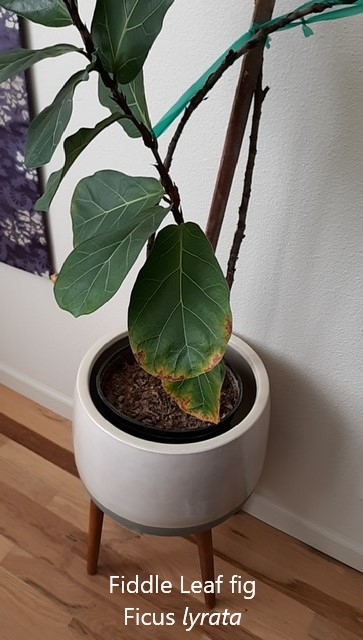
Fiddle leaf figs are finicky! They want a certain level of light and humidity. The dislike soil that is too wet or too dry and drafts. The trick is to learn to "listen" to your plant and make adjustments on the onset of any issue. The information listed below will help you place them in the correct location in your home and provide them with the care they need to be their best.
Location, Location, Location: Fiddle leaf figs require a well-lit (they love morning sun) location. When happy they will often grow large and tall. If they are not happy, they show their dislike by appearing spindly, leggy, yellow/brown/dull leaf color, leaf drop, and their general health will suffer. If you do not have a very bright room for them to live, then perhaps it's time to re-home your fiddle leaf. They do not like drafts.A happy healthy fiddle leaf fig tree can grow as tall as ten feet. In our coastal area, it is possible to move your outgrown fiddle leaf to a sheltered spot outdoors such as a patio. Protect it from the wind, sunburn and cold temperatures.
Water: This is the second most important thing to get right. Both over watering and under watering will cause problems. Indications are yellow or brown leaves that drop prematurely. It is always best to be conservative when watering. How do I know when to water? Water when the top two inches are dry. Do not allow the pot to sit in the drained water. Allowing plants to sit in excess water will cause root rot.
Fertilize: Overfeeding your plants will also cause burnt leave margins. Fertilize your fiddle leaf at least once or twice a year in the spring and in the summer. Use a general houseplant fertilizer. Read the directions and remember that “more is not better. To be safe and to not burn your plant use ½ of the recommended strength, but never more than what the label recommends.
Humidity: Since it is a native to tropical rainforest in Africa, the Fiddle leaf loves above average relative humidity. An indication that they are lacking humidity would be a browning of the leaf margin. Do not sit your plant next to a heating source, as there is less relative humidity there. To increase humidity, group plants together, or perhaps if it is a well-loved plant, place a small humidifier next to the plant.
Grooming: Mist leaves with water and wipe with a soft cloth to remove dust and dirt. If the leave margins have become brown, trim with scissors, following the leaf shape. Remove dead and dropped leaves. Look for insects and disease each time you water. Make this a habit each time you water so you can address issues on the onset. For insect and disease information check out our House Plant page on our website.
Pruning: Yes, you can prune fiddle leaf. Pinching the new growth off the ends of the branches will encourage a thicker and bushier plant. When pruning, a milky-white sap will bleed from the cuts. Make sure to blot and clean up to avoid dripping on the floor. It will sprout new leafs from the trunk if you cut the trunk back.
Propagation: Start with a 6" stem tip cutting that is attached to a leaf and place in water for roots to develop. Air layering would be another method.
Toxic: Yes, this is a toxic plant, keep away from children and pets. For information on toxic plants visit our Poisonous Plants page on our website.